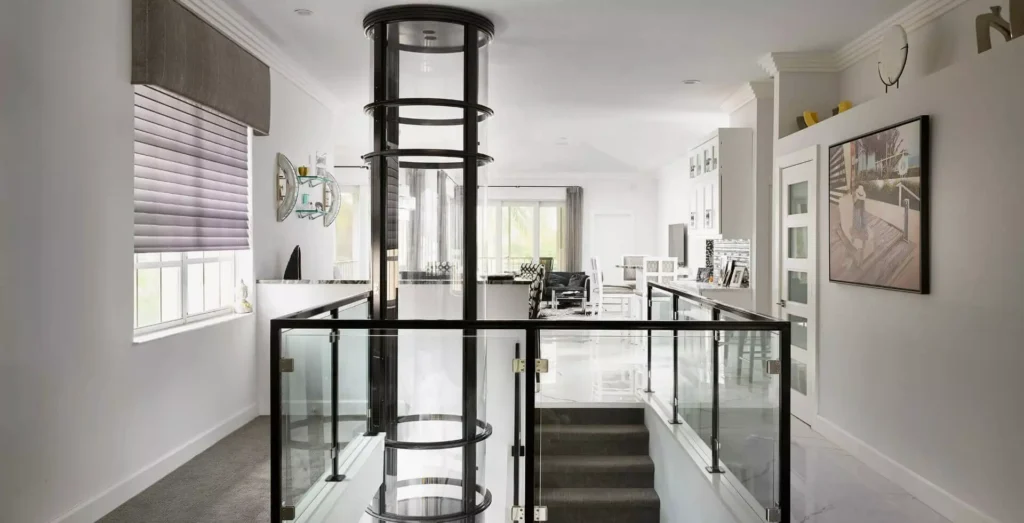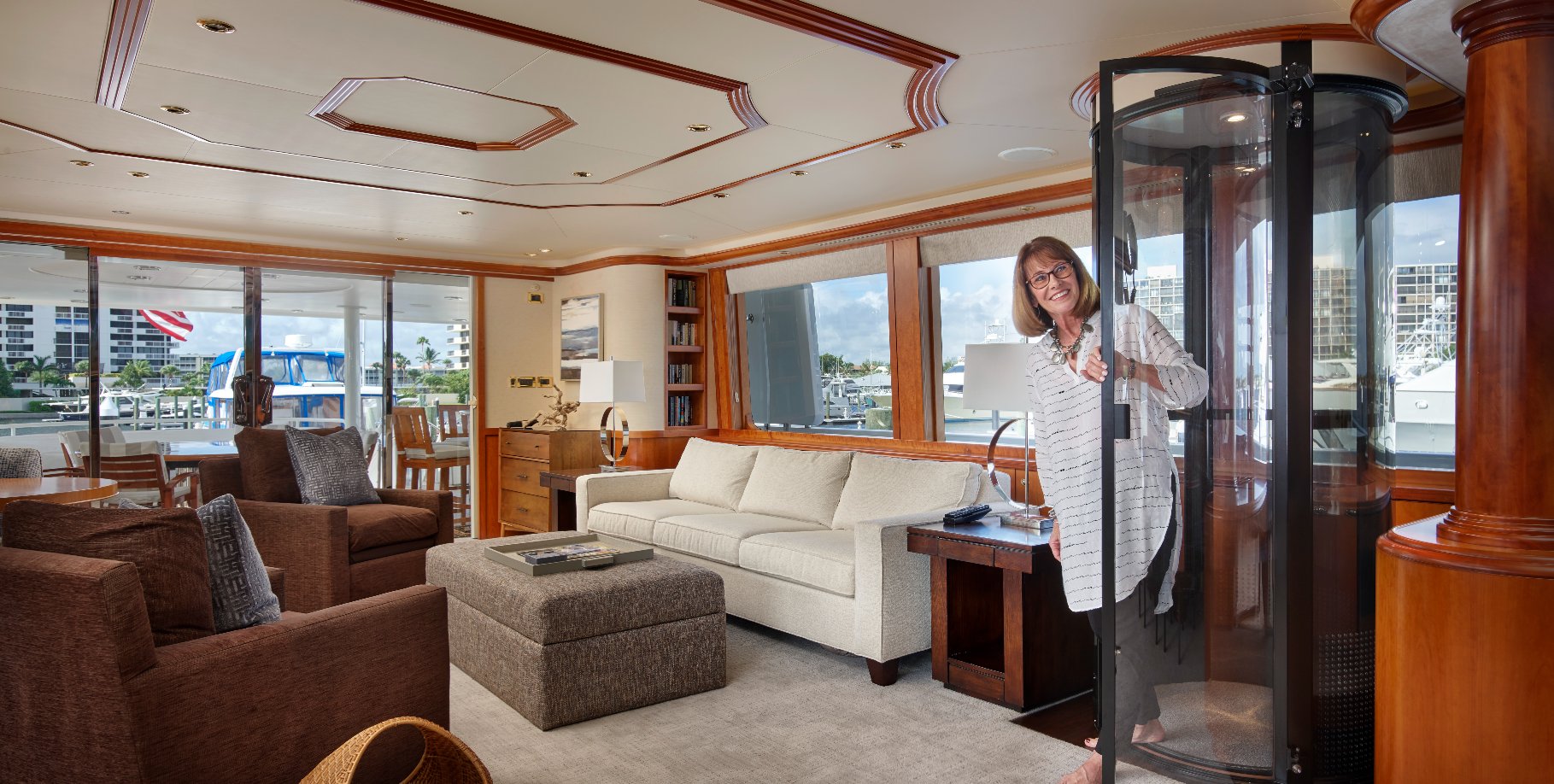Thinking of adding an elevator to your home but worried about space constraints or a hefty price tag? Pneumatic tube elevators, also known as vacuum elevators or pod elevators, might be the perfect solution for you. These innovative lifts offer a sleek, futuristic design housed within a transparent tube, providing a unique and luxurious way to navigate your multi-story haven.
This comprehensive guide dives deep into the world of pneumatic tube elevators, exploring everything you need to know before making this exciting addition to your home. We’ll delve into their functionality, advantages, considerations, and even peek into the future of this technology. By the end, you’ll be a pneumatic tube elevator pro, ready to decide if it’s the perfect fit for your dream home.
How Does a Pneumatic Tube Elevator Work?

Imagine a transparent tube gracefully weaving through your home, carrying you effortlessly between floors. That’s the magic of a pneumatic tube elevator. But how exactly does it work?
The core principle lies in utilizing air pressure. Here’s a breakdown of the mechanics:
- The Tube: The elevator itself resides within a sturdy, transparent tube, typically made of high-quality polycarbonate or acrylic. This tube acts as the elevator shaft and provides a panoramic view during your ride.
- The Elevator Car: The car, a comfortable capsule designed for one or two passengers, is fitted with an airtight seal at the top. It travels smoothly on rails or guide columns within the tube.
- The Power of Pressure: The secret lies in the manipulation of air pressure at the top of the tube. Powerful, yet quiet, electric turbines create a vacuum above the car. This pressure differential essentially “lifts” the car upwards within the tube.
- Controlled Descent: To descend, the process reverses. Electronically controlled valves slowly allow air back into the top of the tube, gently lowering the car at a predetermined speed.
Advantages of Soaring in a Tube: Why Choose a Pneumatic Elevator?

Pneumatic tube elevators offer a compelling set of advantages compared to traditional elevators, making them a popular choice for modern homes. Here are some key benefits:
- Space-Saving Marvels: Traditional elevators require dedicated shafts, machine rooms, and pits, consuming valuable square footage. Pneumatic elevators eliminate this need. The self-supporting tube structure can be installed virtually anywhere in your home, maximizing space utilization.
- Effortless Installation: Due to their simpler design, pneumatic elevators often require less complex installation compared to traditional systems. This translates to shorter installation times and potentially lower upfront costs.
- Aesthetics with a View: The transparent tube transforms the elevator from a utilitarian necessity into a stunning architectural focal point. Imagine gliding between floors while enjoying a panoramic view of your home – a truly unique experience.
- Quiet Operation: Gone are the days of noisy elevator rides. Pneumatic elevators operate with minimal noise, ensuring a peaceful ambiance throughout your home.
- Energy Efficiency: These elevators utilize air pressure, a readily available resource, making them an energy-efficient option compared to traditional elevators that rely on electric motors.
- Accessibility Considerations: Certain models offer wider car sizes, making them suitable for wheelchair users. Additionally, the absence of a pit eliminates a potential safety hazard for children and pets.
- Modern Appeal: The sleek, futuristic design of pneumatic elevators adds a touch of modern luxury to any home, making a bold statement about your style.
Things to Consider Before Taking the Plunge

While pneumatic tube elevators offer numerous advantages, it’s important to consider certain factors before making a decision. Here are some key points to ponder:
- Weight Capacity: These elevators typically have a lower weight capacity compared to traditional elevators. This might be a consideration if you have large families or frequently transport heavy items.
- Number of Floors: Pneumatic elevators are well-suited for homes with 2-4 stories. Taller buildings might require a more robust elevator system.
- Building Codes and Regulations: Ensure pneumatic elevators are compliant with local building codes and regulations in your area.
- Maintenance Needs: Regular maintenance is crucial for optimal performance and safety. Factor in the cost and availability of qualified service providers for pneumatic elevators.
- Cost Considerations: While generally less expensive than traditional elevators, pneumatic elevators still represent a significant investment. Obtain quotes from reputable companies to determine the total cost, including installation and potential ongoing maintenance.
A Glimpse into the Future: Advancements in Pneumatic Tube Elevator Technology
- Enhanced Speed and Efficiency: Research and development are underway to improve the speed of pneumatic elevators, making them even more practical for everyday use.
- Smart Home Integration: Imagine seamlessly integrating your pneumatic elevator with your smart home system. Voice commands or smartphone apps could control your ascent and descent, adding another layer of convenience.
- Customizable Experiences: The future might see personalized experiences within the elevator pod. Imagine having mood lighting, music, or even video displays tailored to your preferences for each journey.
- Safety Innovations: Safety is paramount. Advanced safety features such as automatic emergency stop protocols and redundant pressure systems are continuously being explored to ensure a secure and reliable experience.
The Verdict: Is a Pneumatic Tube Elevator Right for You?
After delving into the world of pneumatic tube elevators, the final question remains: is it the right fit for your home? Here’s a quick decision matrix to help you determine:
| Factor | Advantage | Disadvantage |
|---|---|---|
| Space Saving | Maximizes usable space | Requires a clear, unobstructed path for the tube |
| Installation | Relatively simpler and faster installation | May require modifications to existing structures |
| Aesthetics | Stunning architectural feature with panoramic view | Dominant visual presence might not suit all styles |
| Operation | Quiet and smooth rides | Limited weight capacity |
| Energy Efficiency | Energy-efficient due to air pressure | Regular maintenance is crucial |
Ultimately, the decision rests on your specific needs, budget, and aesthetic preferences. If you value space-saving design, futuristic aesthetics, and a unique way to navigate your home, a pneumatic tube elevator could be a fantastic addition. However, consider your weight capacity requirements, building regulations, and ongoing maintenance needs before making your final choice.
Final Thoughts
Pneumatic tube elevators offer a revolutionary and luxurious way to experience vertical mobility in your home. Their sleek design, space-saving nature, and quiet operation make them a compelling alternative to traditional elevators. While some considerations need to be taken into account, advancements in technology promise even greater versatility and efficiency in the future.
If you’re looking to elevate – literally and figuratively – your living space, a pneumatic tube elevator might be the key to unlocking a futuristic and exciting way to navigate your multi-story haven.
Frequently Asked Questions About Pneumatic Tube Elevators
Dimensions and Space Requirements:
- How big are pneumatic tube elevators?
The diameter of the tube typically ranges from 30 to 40 inches, accommodating one or two passengers comfortably. The overall footprint depends on the chosen model and how it’s integrated into your home.
- Do I need a dedicated shaft for a pneumatic elevator?
No, unlike traditional elevators, pneumatic elevators don’t require a dedicated shaft. The self-supporting tube structure can be installed along a wall, maximizing space utilization.
- Can a pneumatic elevator be retrofitted into an existing home?
Yes, in most cases, pneumatic elevators can be retrofitted into existing homes with minimal structural changes. However, a clear, unobstructed path for the tube is necessary.
Usage and Capacity:
- How many floors can a pneumatic elevator serve?
Pneumatic elevators are well-suited for homes with 2-4 stories. Taller buildings might require a more robust elevator system.
- What is the weight capacity of a pneumatic elevator?
The weight capacity typically ranges from 350 to 500 pounds, making them suitable for most individuals and light cargo. However, it’s important to confirm the specific capacity of the chosen model.
- Are pneumatic elevators safe for children and pets?
Yes, pneumatic elevators prioritize safety. They typically have automatic safety features and lack a pit, eliminating a potential fall hazard.
Speed, Operation, and Maintenance:
- How fast are pneumatic elevators?
The average speed is around 30-40 feet per minute, slower than traditional elevators but sufficient for short trips within a home.
- How noisy are pneumatic elevators?
They operate very quietly due to the use of air pressure. This ensures a peaceful environment throughout your home.
- How often does a pneumatic elevator require maintenance?
Regular maintenance is crucial, typically recommended every 1-2 years. Ensure the availability of qualified service providers in your area.
Cost and Regulations:
- How much does a pneumatic elevator cost?
Generally less expensive than traditional elevators, the cost can vary depending on the model, size, and complexity of the installation. Expect a range of $30,000 to $70,000.
- Do I need special permits to install a pneumatic elevator?
Yes, it’s crucial to check with your local building department to ensure pneumatic elevators comply with building codes and regulations in your area.
Additional Considerations:
- Can pneumatic elevators be customized?
While customization options might be limited compared to traditional elevators, some manufacturers offer features like tinted or frosted tubes for privacy.
- Are pneumatic elevators energy-efficient?
Yes, they utilize readily available air pressure, making them a more energy-efficient option than traditional electric motor-driven elevators.
- Is it possible to integrate a pneumatic elevator with a smart home system?
While not yet widespread, advancements are being made to allow for voice control or smartphone app integration for a truly smart home experience.
- What are the future prospects for pneumatic elevator technology?
The future looks bright! Developments are underway to increase weight capacity, speed, and even incorporate customizable features within the elevator pod.








